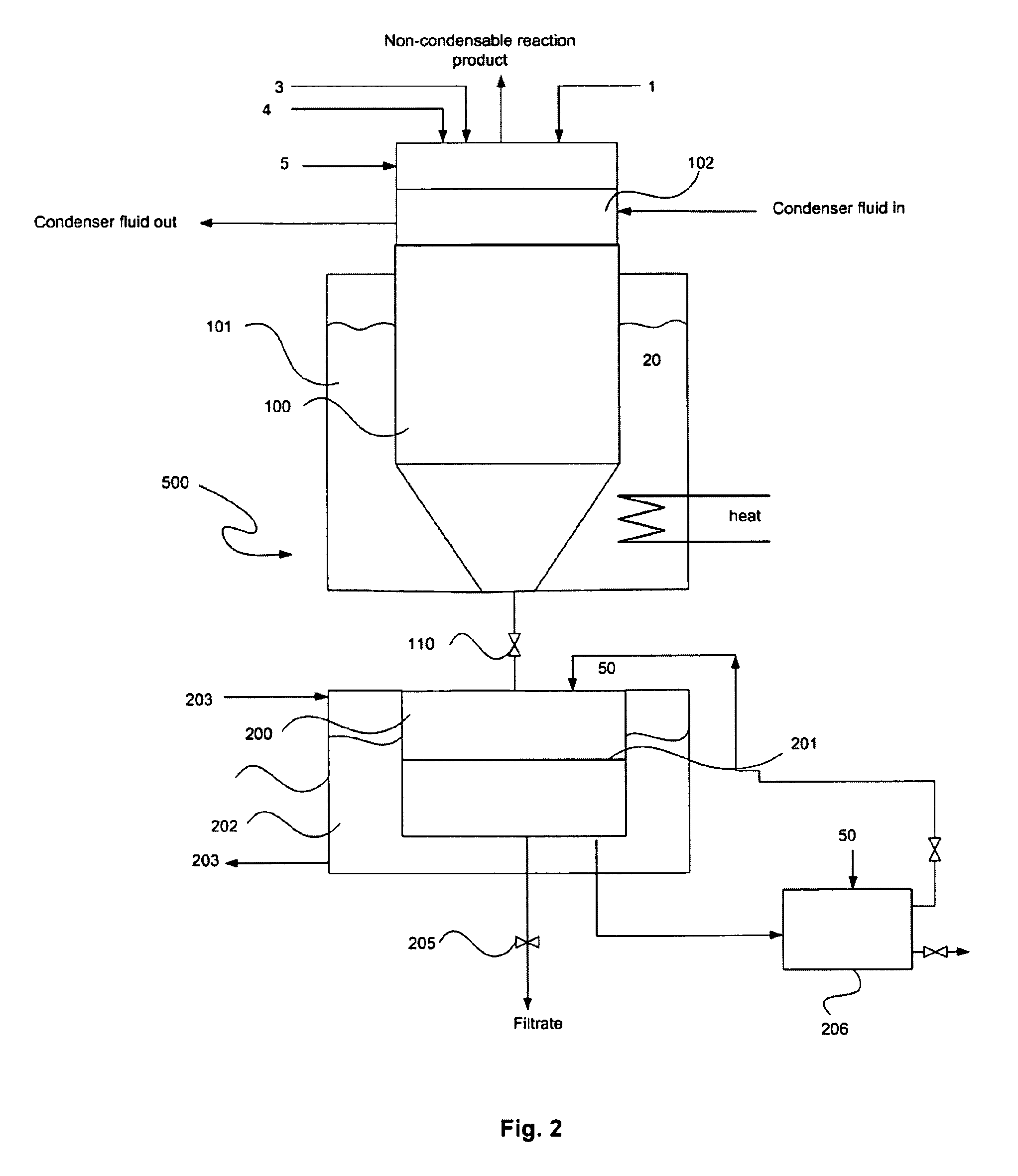Method for preparing a supported ruthenium catalyst
a technology of ruthenium and catalyst, which is applied in the direction of metal/metal-oxide/metal-hydroxide catalyst, inorganic chemistry, fuel cells, etc., can solve the problems of deteriorating the catalyst performance during use at high temperatures, energy and time-consuming decomposition of ammonia,
- Summary
- Abstract
- Description
- Claims
- Application Information
AI Technical Summary
Benefits of technology
Problems solved by technology
Method used
Image
Examples
example 1
Preparation of 2% Ru / Al2O3 (without Nano-Powder)
[0039]A Ru catalyst was prepared as follows: 225 ml of ethylene glycol was added to a round bottom flask. 0.68 g of hydrated RuCl3 (RuCl3.˜3H2O) was added to the ethylene glycol. The mixture was stirred magnetically at room temperature for 60 min. 15 g of alumina pellets (average diameter 1 mm) was added to the flask. A condenser was added to the flask and the assembly was put into a silicon oil bath with oil temperature at 180° C. After 18 minutes, the flask was removed from the oil and inserted into ice for e.g. 30 min. A NaNO3 solution was prepared with 34.4 g of NaNO3 in 1.3 l of DI water. The mixture in the round bottom flask was then added to the NaNO3 solution and the mixture was magnetically stirred for e.g. 30 min. The resulting mixture was then filtered with a Hirsch funnel. The obtained coated Al2O3 pellets were then kept open to the ambient for 8 h.
example 2
Preparation of 2% Ru / Al2O3 (with Alumina Nano-Powder)
[0040]A Ru catalyst was prepared as follows: 75 ml of ethylene glycol was added to a round bottom flask. 0.23 g of hydrated RuCl3 (RuCl3.˜3H2O) and 0.53 g of γ-alumina nano-powder were added to the ethylene glycol. The mixture was sonicated for 10 min before stirring magnetically at room temperature for 60 min. Five (5) g of alumina pellets (average diameter 1 mm) was added to the flask. A condenser was added to the flask and the assembly was put into a silicon oil bath with oil temperature at 180° C. After 18 minutes, the flask was removed from the oil and inserted into ice for e.g. 30 min. A NaNO3 solution was prepared with 12 g of NaNO3 in 450 ml of DI water. The mixture in the round bottom flask was then added to the NaNO3 solution and the mixture was magnetically stirred for 10 min, 20 min or 30 min. The resulting mixture was then filtered with a Hirsch funnel. The obtained coated Al2O3 pellets were then kept open to the ambi...
example 3
2% Ru / Al2O3 (with CeO2 Nano-Powder)
[0041]A Ru catalyst was prepared as follows: 225 ml of ethylene glycol was added to a round bottom flask. 0.683 g of hydrated RuCl3 (RuCl3.˜3H2O) and 2.69 g of CeO2 nano-powder were added to the ethylene glycol. The mixture was sonicated for 10 min before stirring magnetically at room temperature for 60 min. Fifteen (15) g of alumina pellets (average diameter 1 mm) was added to the flask. A condenser was added to the flask and the assembly was put into a silicon oil bath with oil temperature at 180° C. After 18 minutes, the flask was removed from the oil and inserted into ice for e.g. 30 min. A NaNO3 solution was prepared with 34 g of NaNO3 in 41.3 l of DI water. The mixture in the round bottom flask was then added to the NaNO3 solution and the mixture was magnetically stirred for 30 min. The resulting mixture was then filtered with a Hirsch funnel. The obtained coated Al2O3 pellets were then kept open to the ambient for 8 h.
PUM
| Property | Measurement | Unit |
|---|---|---|
| pH | aaaaa | aaaaa |
| temperature | aaaaa | aaaaa |
| size | aaaaa | aaaaa |
Abstract
Description
Claims
Application Information
 Login to View More
Login to View More - R&D
- Intellectual Property
- Life Sciences
- Materials
- Tech Scout
- Unparalleled Data Quality
- Higher Quality Content
- 60% Fewer Hallucinations
Browse by: Latest US Patents, China's latest patents, Technical Efficacy Thesaurus, Application Domain, Technology Topic, Popular Technical Reports.
© 2025 PatSnap. All rights reserved.Legal|Privacy policy|Modern Slavery Act Transparency Statement|Sitemap|About US| Contact US: help@patsnap.com



